 |
||
|
1940 Olympics. The women's trials were held, but not the men's. The nation's best breaststroker, Fujiko Katsutani, was selected for the U.S. Olympic Team. The World War cancelled the 1940 games. Thru exhaustive work by former local Olympian - Sonny Tanabe, the Olympic Committee inducted Maui's Fujiko Katsutani, as an Olympian! Congratulations go out to Fujiko, although 60 years late! |
||
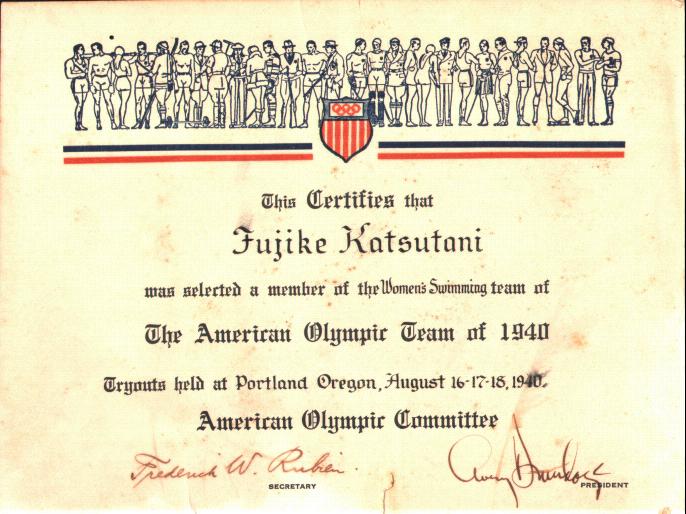 |
||
|
|
||
|
Two years later, in 1939, she was on
her way to Des Moines, Iowa to swim in the AAU Outdoor National
Championships for women. The 14 year old Fujiko had captured
the Gold medal in the 200 meters breaststroke.
That year however, because of the World War, the Olympics
were canceled. All the training, the sacrifice, the discipline, the dedication
and then the disappointment.
No dating, no dancing, no socializing. The Dedication. During the summer schedule,
she would catch the bus from Wailuku with some of her team mates
at 6:00 AM. They would then get a transfer in Kahului and head
to the Puunene swimming pool and start training at 6:30 AM. The camp residents would come out and help time some of the
swimmers every afternoon. Takeo Shibuya, Goichi (Kipa) Fujioka,
Yoshitsugi Katayama and Shigeki Tamura was some of the people
that Fujiko could remember. The funds raised by Mr. Tamura would
be used to help Coach Sakamoto in his travels to O'ahu and to
the mainland for elite competition. The summer schedule training both in the water and on dryland
extended their day with Coach Sakamoto from 6:30 AM to 8:00 in
the evening When Fujiko first started training in 1937, she would return
home after practice at 8:00 at night, only to be kicked out
of the house. In this family of eleven (11), that's 4 brothers and 5 sisters along with the two very supportive parents. In this big family; time, money and attention didn't come easy. Fujiko was the 6th of 9 children. Her mom was the most supportive
of Fujiko's efforts. When she came home late at night after work outs, Mom knew
how fussy Fujiko was about eating certain kinds of foods, and
would be there to cook a special meal for her. When Fujiko was ready to travel to the Nationals, her mom would find the time, and help her get ready for the trip. Her mom was special.
To swim in the 1939 AAU Outdoor National Championships Meet, Fujiko needed a team to sponsor her. At first, the Alexander House Swim team turned her down, stating that Fujiko wasn't ready for the mainland competition and that she needed a female chaperone. |
Coach Sakamoto stepped in and argued the point ! Coach knew that Fujiko was ready, and this was the time to do it. Coach Sakamoto found funding thru Honolulu's George Higa.
Two days later, Fujiko won the 200 meter Breaststroke. "When you train, you train because you want to become
a champion", says Fujiko. "The best time, is when you are training to become a
champion. Once you've become a champion, someone is waiting to
knock you off. To be up there, you need to train and be good." Presently Fujiko has shared her life with her husband, Zuke
Matsui for the past 49 years! Zuke is of the first startup group 442nd Regimental Combat
Team. (The most decorated unit in WorIdWar II !) Zuke and Fujiko has two children. Their son Lee, is an agent
for H.G.E.A. "I tell him to pace himself', Fujiko
says, "He's really a hard worker." Their daughter Colleen currently works at Horita Development,
in Maui. Colleen has three children: On the Katsutani side, there is one budding swimmer. Currently, she's 12 years old, loves the water and has just started swimming competitively.
"Dana's freestyle turn over is that of a middle distance swimmer, just like mine" says Fujiko.
"Dana, are you pulling underwater like this or like that
?" Referring to the breastroke. "I think Aunty Fujiko still has the eye for swimming !" says her nephew Calvin (Dana's Dad.) "Coach Sakamoto has sacrificed his life to swimming and has helped people like me (Fujiko) to excel in the sport." "A great deal of sacrifice surely came from Missus Sakamoto and the Sakmoto children", says Fujiko. She, (Fujiko) sincerely appreciates all the help she got from Coach and Missus. Adds Keo Nakama, "Fujiko was the Territorial Champion for breaststroke at age 14. Shewas truly outstanding." I remember when Coach Sakamoto took her to Des Moines, then they joined up with us in Detroit. She did well at the Women's Nationals. The 1939 National Team consist of the following swimmers: From the Island of O'ahu
From Seattle, Coach Sakamoto and Fujiko flew to Des Moines, Iowa for the National Championships. Later they joined the boys in Detroit. |
|
 Fujiko Katsutani
made an oath of promise to Coach Soichi Sakamoto
that she would train. hard.
Fujiko Katsutani
made an oath of promise to Coach Soichi Sakamoto
that she would train. hard.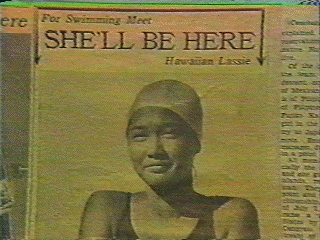 The following year,
1940, she traveled to Portland, Oregon to compete in the AAU
National Championships. Again, she captured first in the
200 meter breaststroke.
The following year,
1940, she traveled to Portland, Oregon to compete in the AAU
National Championships. Again, she captured first in the
200 meter breaststroke.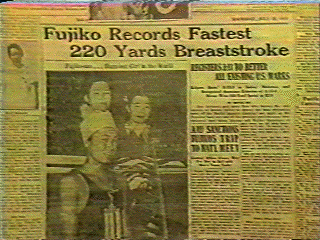 Winning 1st in the
Nationals also meant that she qualified for the Olympics.
Winning 1st in the
Nationals also meant that she qualified for the Olympics. The Sacrifice..
Giving up all activities to train and essentially become
the best in the United States.
The Sacrifice..
Giving up all activities to train and essentially become
the best in the United States.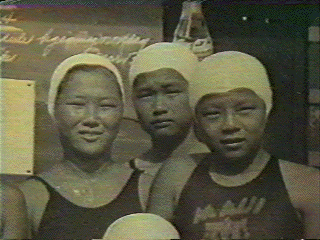 Fujiko
would be the breaststroker, her team. mates Chic Miyamoto excelled
in freestyle, Mitsuko Higuchi and Toyo Takeyama in Backstroke.
Her other teammates Lulu Nakagawa and Bertha Ching helped propel
the Medley and Freestyle Relay.
Fujiko
would be the breaststroker, her team. mates Chic Miyamoto excelled
in freestyle, Mitsuko Higuchi and Toyo Takeyama in Backstroke.
Her other teammates Lulu Nakagawa and Bertha Ching helped propel
the Medley and Freestyle Relay.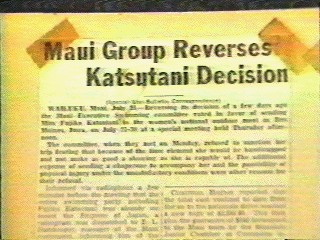 The owner of the
Alexander House team finally approved the travel, and Fujiko
was on her way to the Nationals.
The owner of the
Alexander House team finally approved the travel, and Fujiko
was on her way to the Nationals.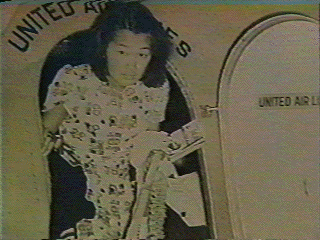 After a 7 day long
journey on the ship, Fujiko was deathly ill. She dragged herself
on deck and got into the pool. As soon as she got into the pool,
she felt better.
After a 7 day long
journey on the ship, Fujiko was deathly ill. She dragged herself
on deck and got into the pool. As soon as she got into the pool,
she felt better.